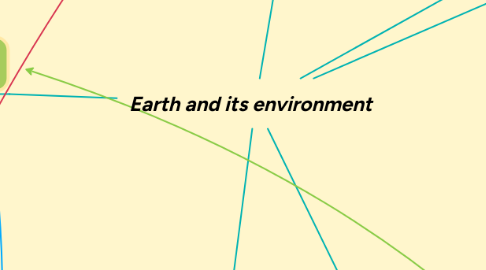
1. THREATS/MAINFESTATIONS
1.1. POLLUTION
1.1.1. AIR POLLUTION
1.1.1.1. TRANSPORTATION
1.1.1.2. FACTORIES AND INDUSTRIES
1.1.1.3. VOLCANO ERUPTION
1.1.1.4. FOREST FIRES
1.1.2. NOISE POLLUTION
1.1.2.1. TRANSPORT
1.1.2.2. MACHINES
1.1.2.3. PROCESSIONS
1.1.3. WATER POLLUTION
1.1.3.1. CHEMICALS FROM INDUSTRIES
1.1.3.2. AGRICULTURAL ACTIVITIES
1.1.3.3. SEWAGE
1.1.4. RADIOACTIVE WASTE
1.1.4.1. IRRESPONSIBLE HANDLING OF NUCLEAR WASTE
1.1.4.2. NUCLEAR ACCIDENTS
1.2. GLOBAL WARMING
1.2.1. Global warming is the long-term rise in the average temperature of the Earth's climate system
1.2.2. Caused by
1.2.2.1. Industrialization
1.2.2.2. Burning fossil fuels
1.2.2.3. deforestation
1.2.2.4. Green house gases
1.2.3. Leads to
1.2.3.1. Melting of ice caps
1.2.3.2. Rising of sea levels
1.2.3.3. loss of biodiversity
1.2.3.4. Acceleration of climate change
2. ECOSYSTEM
2.1. BIOTIC FACTORS
2.1.1. ECOSYSTEM
2.1.1.1. a biological community of interacting organisms and their physical environment.
2.1.2. BIOMES
2.1.2.1. TUNDRA
2.1.2.2. GRASSLANDS
2.1.2.3. TROPICAL RAINFORESTS
2.1.2.4. AQUATIC
2.1.2.4.1. MARINE
2.1.2.4.2. FRESHWATER
2.1.2.5. DESSERTS
2.1.3. LIFE
2.1.3.1. CLIMATIC ADAPTATION
2.1.3.1.1. ARCTIC FOX
2.1.3.1.2. CAMELS
2.1.3.1.3. LIZARDS
2.1.3.1.4. LARGE FISH AND MAMMALS
2.2. ABIOTIC FACTORS
2.2.1. CLIMATE
2.2.1.1. Climate means the usual condition of the temperature, humidity, atmospheric pressure, wind, rainfall, and other meteorological elements in an area of the Earth's surface for a long time
2.2.1.2. CLIMATE CHANGE
2.2.1.2.1. MILANKOVITCH CYCLE
2.2.1.3. CLIMATE ZONES CLASSIFICATION
2.2.1.3.1. CLIMATE ZONES
2.2.1.3.2. KOPPEN-GEIGER CLASSIFICATION
2.2.1.4. PALEOCLIMATOLOGY
2.2.1.4.1. Sedimentary deposits
2.2.1.4.2. ICE
2.2.1.4.3. Dendroclimatolohy
2.2.2. WEATHER
2.2.2.1. ALWAYS UPRIGHT
2.2.2.2. the state of the atmosphere at a particular place and time as regards heat, cloudiness, dryness, sunshine, wind, rain, etc.
2.2.3. TEMPERATURE
2.2.3.1. Even 1 degree increase very harmful
2.2.3.2. TEMPERATURE CHANGE
2.2.4. SUNLIGHT
2.2.4.1. UV-A
2.2.4.2. UV-B
2.3. ECOLOGICAL PYRAMIDS
2.3.1. PYRAMID OF ENERGY
2.3.2. PYRAMID OF NUMBERS
2.3.3. PYRAMID OF BIOMASS
2.4. Ecological succession
2.4.1. PRIMARY SUCCESSION
2.4.1.1. Community changes occur on an entirely new habitat
2.4.1.1.1. New volcanic rock, glacier retreat etc
2.4.2. SECONDARY SUCCESSION
2.4.2.1. changes take place on a previously colonized habitat
2.4.2.1.1. Examples: forest fires, barren land etc
3. Constitutes all the water bodies of the world
4. SUBSYSTEMS
4.1. LITHOSPHERE
4.1.1. The uppermost part containing the crust and the upper mantle
4.2. ATMOSPHERE
4.2.1. OXYGEN(21%)
4.2.2. Layers of atmosphere
4.2.2.1. STRATOSPHERE
4.2.2.2. TROPOSPHERE
4.2.2.3. MESOSPHERE
4.2.2.4. EXOSPHERE
4.2.2.5. THERMOSPHERE
4.2.3. GASES PRESENT
4.2.3.1. NITROGEN (78%)
4.2.3.2. ARGON (0.93%)
4.2.3.3. CARBON DIOXIDE (0.04%)
4.2.3.4. TRACES OF OTHER GASES
4.2.4. GREENHOUSE GASES
4.2.4.1. A greenhouse gas is a gas that absorbs and emits radiant energy within the thermal infrared range.
4.2.4.2. GREENHOUSE EFFECT
4.2.4.2.1. process by which radiation from a planet's atmosphere warms the planet's surface to a temperature above what it would be without this atmosphere.
4.2.4.3. PRIMARY GREENHOUSE GASES
4.2.4.3.1. Water vapour
4.2.4.3.2. Methane
4.2.4.3.3. Carbon Dioxide
4.2.4.3.4. Nitrous Oxide
4.2.4.3.5. Ozone
4.3. BIOSPHERE
4.3.1. Regions covered by life on earth
4.4. CRYOSPHERE
4.4.1. Constitutes the polar and arctic regions
4.5. HYDROSPHERE
5. STRUCTURE
5.1. Layers of Earth
5.1.1. CRUST
5.1.2. MANTLE
5.1.2.1. AESTHENOSPHERE
5.1.2.2. MESOSPHERE
5.1.3. CORE
5.1.3.1. INNER CORE
5.1.3.2. OUTER CORE
6. SOLUTIONS
6.1. ENERGY DEVELOPMENT
6.1.1. CONVENTIONAL SOURCES
6.1.1.1. COAL
6.1.1.1.1. Peat
6.1.1.1.2. Lignite
6.1.1.1.3. Bituminous
6.1.1.1.4. Anthracite
6.1.1.2. NATURAL GAS
6.1.1.2.1. Secondary source of energy
6.1.1.3. OIL
6.1.2. NON CONVENTIONAL SOURCES
6.1.2.1. HYDRO ENERGY
6.1.2.1.1. Uses power of water and speed to rotate turbines
6.1.2.1.2. Dams and reservoirs
6.1.2.2. SOLAR ENERGY
6.1.2.2.1. SOLAR ROOFTOP SYSTEM
6.1.2.2.2. SOLAR DIRECT PV SYSTEM
6.1.2.2.3. SOLAR AC SYSTEM
6.1.2.2.4. SOLAR THERMAL POWER SYSTEM
6.1.2.3. GEOTHERMAL ENERGY
6.1.2.3.1. Geothermal energy is the heat that comes from the sub-surface of the earth.
6.1.2.4. WIND ENERGY
6.1.2.4.1. Needs Land area
6.1.2.4.2. optimum wind speed
6.1.2.4.3. maintanence of systems
6.1.2.5. HYDROGEN ENERGY
6.1.2.5.1. Fuel cells
6.1.2.5.2. Still a developing research
6.1.2.6. BIOMASS ENERGY
6.1.2.6.1. Mostly used in rural areas
6.1.2.6.2. produces bad odour
6.1.3. HYBRID SYSTEMS
6.1.3.1. Hybrid systems are made up of two or more renewable energy systems to improve system efficiency and greater returns
6.1.3.1.1. Examples: Solar-wind system, battery-pv-wind system, Wind-Hydro system.
6.1.3.2. Cost and energy efficient.
6.2. CARBON CREDITS
6.2.1. A carbon credit is a permit or certificate allowing the holder, such as a company, to emit carbon dioxide or other greenhouse gases.
6.2.2. EARN A CARBON CREDIT BY
6.2.2.1. Planting trees
6.2.2.2. reducing nitrous oxide emissions
6.2.2.3. Managing stocks by allowing a native forest to grow
6.3. BEHAVIORAL CHANGES
6.3.1. Self-interest
6.3.1.1. Motivates us
6.3.1.1.1. Altered behaviour
6.4. REDUCING CARBON FOOTPRINT
6.4.1. Shift to renewable energy
6.4.2. Don't waste food
6.4.3. Walk or cycle
6.4.4. Use public transportation
6.5. INTERNATIONAL AGREEMENTS
6.5.1. UNFCCC
6.5.1.1. PARIS AGREEMENT
6.5.1.1.1. 196 countries
6.5.1.1.2. Reduce GHG emissions
6.5.1.2. KYOTO PROTOCOL
6.5.1.2.1. Divided countries into
6.5.1.2.2. Extends the 1992 UNFCCC agreement
6.5.1.2.3. commits different organizations to reduce green house emissions,
6.5.1.3. Technology transfer
6.5.1.3.1. Transfer of technology from developed to developing to boost their economies.
6.5.2. IPCC
6.5.2.1. Analyses and provides world with climate change data

